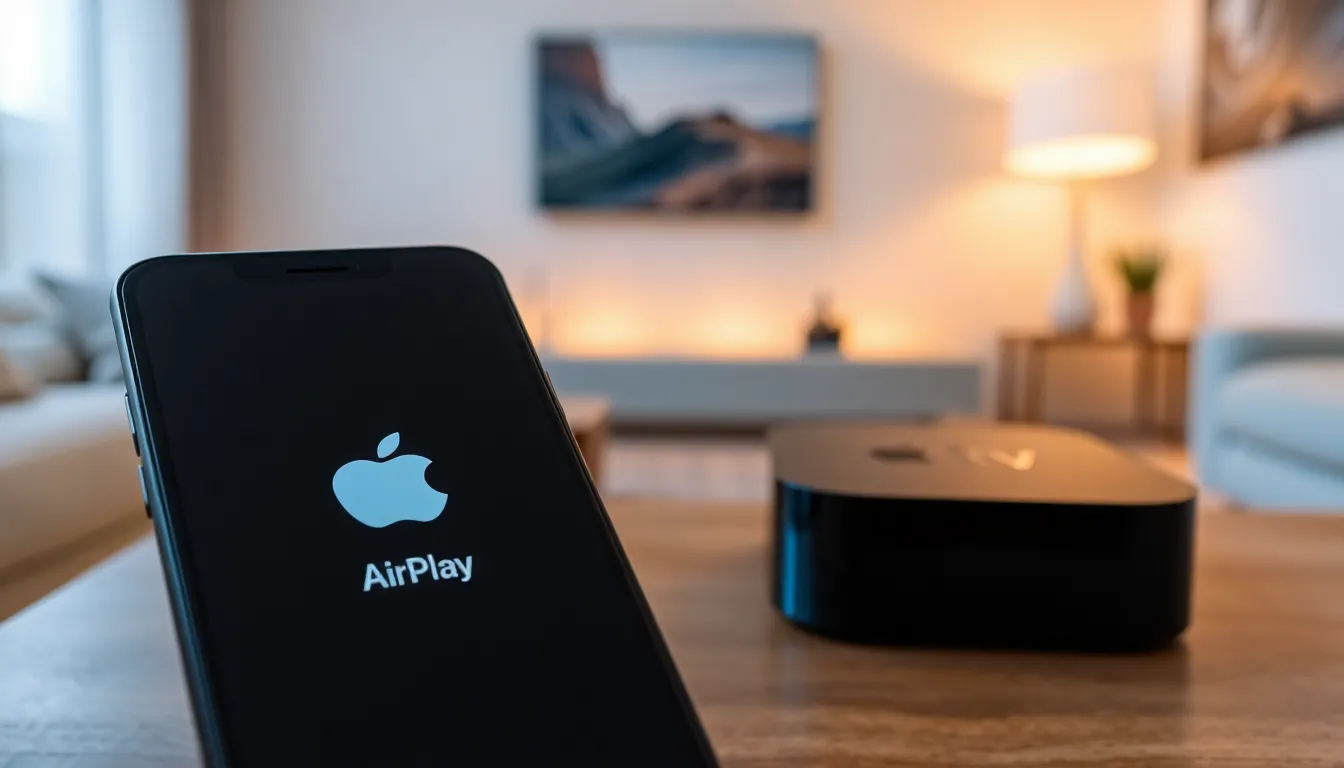Table of Contents
ToggleImagine sitting on your couch, remote in one hand and your iPhone in the other, ready to unleash a cinematic experience right from your pocket. With AirPlay, it’s like having a magic wand that turns your iPhone into a portal for sharing videos, music, and photos on the big screen. No more squinting at that tiny display; it’s time to let your content shine!
Understanding AirPlay
AirPlay provides a seamless way to stream content from an iPhone to compatible devices. This functionality enhances enjoyment by allowing users to share media on a larger screen effortlessly.
What Is AirPlay?
AirPlay is Apple’s wireless streaming protocol. It enables devices like iPhones, iPads, and Macs to send audio and video to AirPlay-enabled devices such as Apple TV or smart speakers. Compatibility with various formats makes it easy to connect different types of media. Streaming can occur over Wi-Fi, maintaining high-quality playback while reducing the need for cables.
Benefits of Using AirPlay
Using AirPlay offers multiple advantages. First, it allows for easy sharing of photos and videos during gatherings. Second, users benefit from streaming music directly to speakers without interruptions. Third, AirPlay supports screen mirroring, making presentations more accessible. Additionally, it’s user-friendly, requiring minimal setup for quick connections. Finally, maintaining high-quality audio and video ensures that content looks and sounds excellent on larger displays.
Setting Up AirPlay on iPhone

Setting up AirPlay on an iPhone is straightforward, ensuring a smooth streaming experience. Familiarity with the necessary steps is key.
Checking Compatibility
Ensure that the iPhone runs iOS 4.2 or later to use AirPlay. Compatible devices include Apple TV, AirPlay-enabled speakers, and smart TVs. Checking the manufacturer’s specifications verifies AirPlay support. Additionally, devices using the same Wi-Fi network enhance connectivity. Some third-party apps also support AirPlay, expanding streaming options further.
Connecting to Wi-Fi
Connecting to Wi-Fi is crucial for using AirPlay. Access the Settings app and tap on Wi-Fi. Select a network and enter the password if prompted. Ensure the iPhone and the AirPlay device connect to the same network for seamless streaming. A strong Wi-Fi connection improves streaming quality and reduces lag. Checking the connection status in Settings ensures everything is set up correctly.
How to Do AirPlay on iPhone
AirPlay streamlines sharing content from an iPhone to larger screens. The following sections detail how to utilize this feature effectively.
Using the Control Center
Access the Control Center for easy AirPlay options on an iPhone. Users swipe down from the top-right corner on iPhone X and later or swipe up from the bottom on earlier models. Tap on the Screen Mirroring or AirPlay icon, then select the desired device from the list. Successful connection signals readiness for streaming. A solid Wi-Fi connection proves essential for maintaining quality during playback. Control playback directly from the iPhone, offering seamless transitions between content.
Streaming Content from Apps
Numerous apps support AirPlay, enabling direct streaming to compatible devices. Open the desired app, locate the playback controls, then tap the AirPlay icon. Selecting a device from the list initiates playback on the larger screen. YouTube, Netflix, and Apple Music exemplify apps with built-in AirPlay support. Media playback options expand as users enjoy photo slideshows, music, and videos during social gatherings. Combining access to popular apps with AirPlay enhances overall enjoyment and engagement.
Troubleshooting AirPlay Issues
AirPlay can occasionally present challenges for users. Identifying common problems can facilitate a smoother streaming experience.
Common Problems
Connectivity issues frequently arise when devices aren’t on the same Wi-Fi network. Users often encounter lag or buffering, affecting the playback quality. Incompatible devices may limit functionality, especially with older models. Users might also face restrictions with certain apps, meaning not all content streams correctly. Device firmware not being up to date can cause additional problems, as it impacts compatibility and performance.
Solutions and Tips
Ensuring both the iPhone and the AirPlay device connect to the same Wi-Fi network resolves many connectivity issues. Restarting both devices often clears temporary glitches. Checking for software updates on the iPhone and the AirPlay device can enhance performance significantly. Users should also restart their Wi-Fi router if problems persist. Testing streaming with different apps helps determine if the issue is app-specific. Additionally, reducing the distance between the iPhone and the AirPlay device often improves signal strength and streaming consistency.
AirPlay transforms how users experience media by effortlessly streaming content from their iPhones to larger screens. With its user-friendly interface and high-quality output, it’s become an essential tool for anyone looking to enhance their viewing and listening experiences. Whether sharing videos at a party or mirroring presentations, AirPlay simplifies the process while maintaining impressive performance.
By following the outlined steps and troubleshooting tips, users can maximize their AirPlay experience. This technology not only fosters connection among friends and family but also elevates personal entertainment to new heights. Embracing AirPlay opens up a world of possibilities for enjoying media in a more engaging and immersive way.



